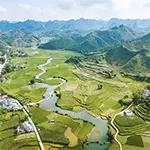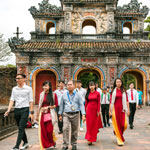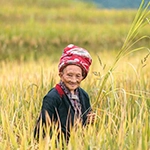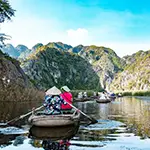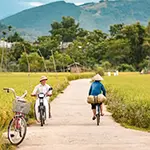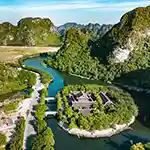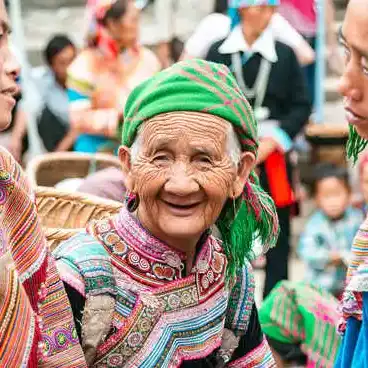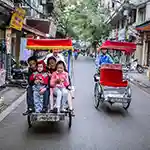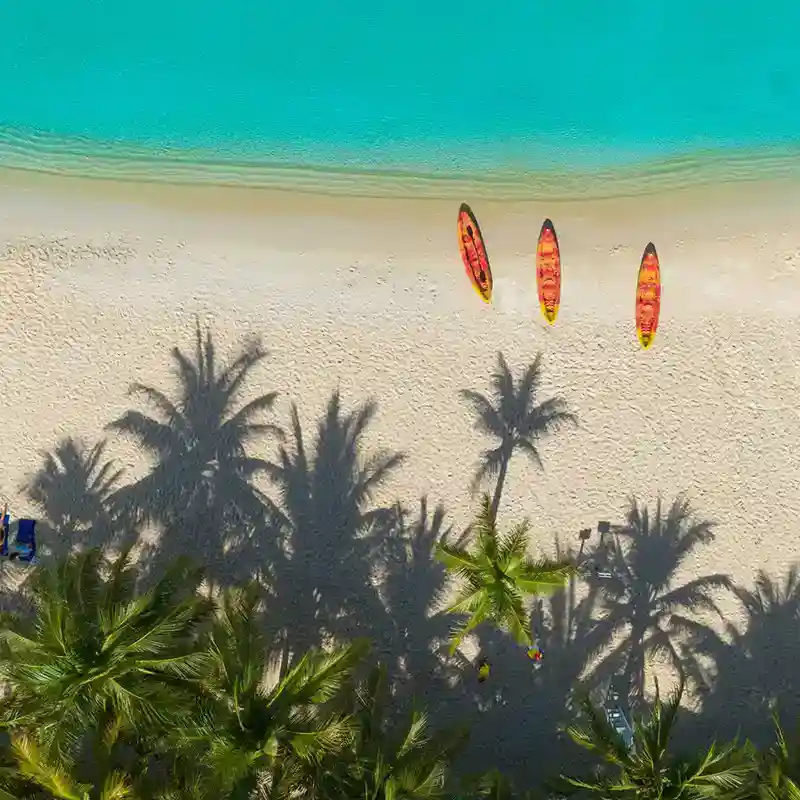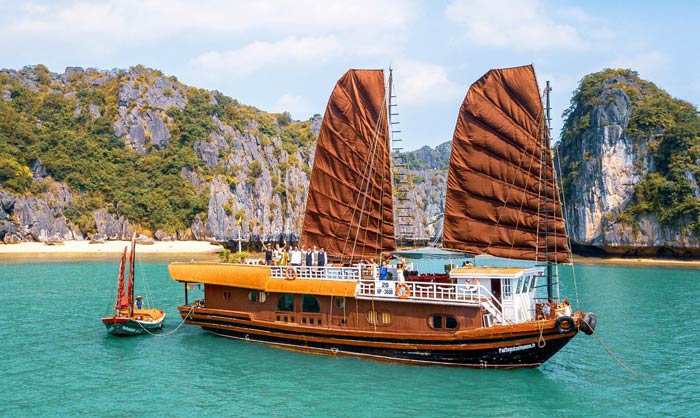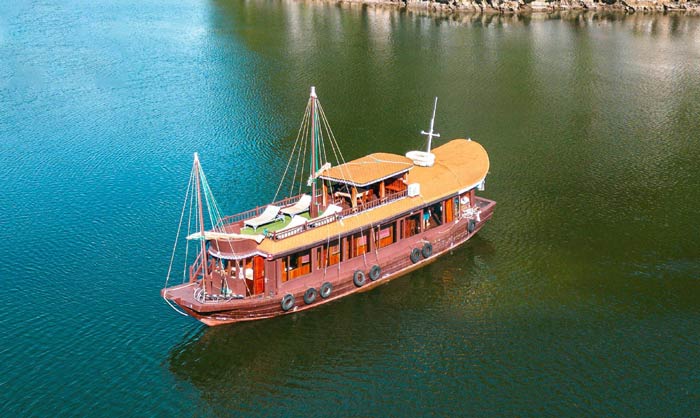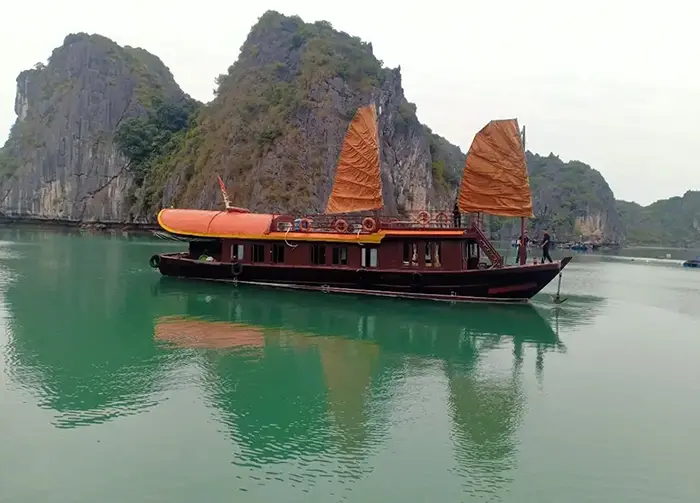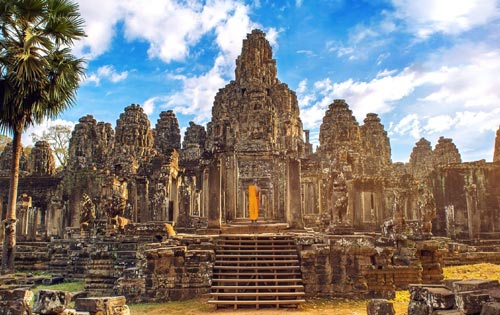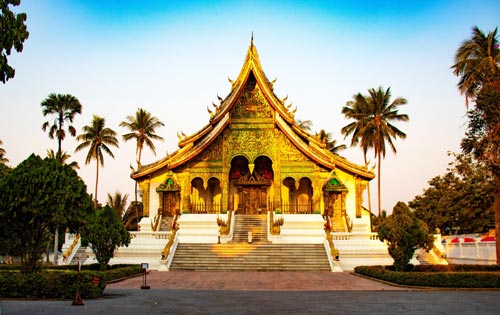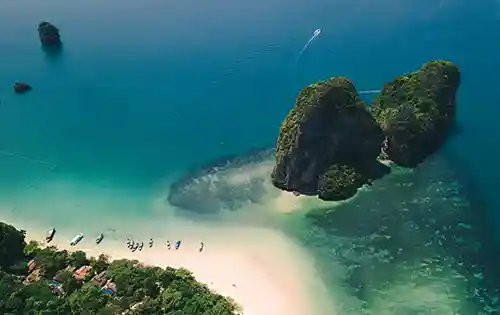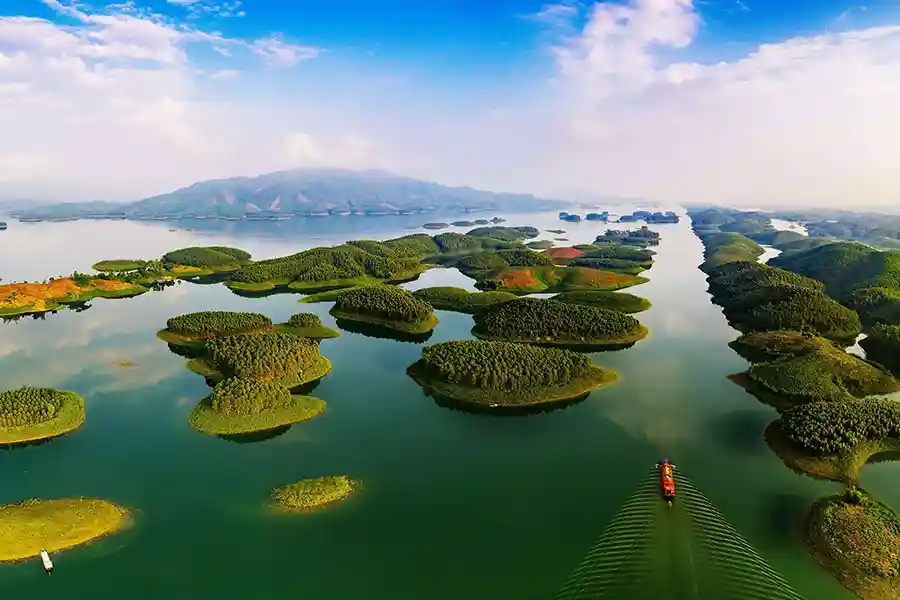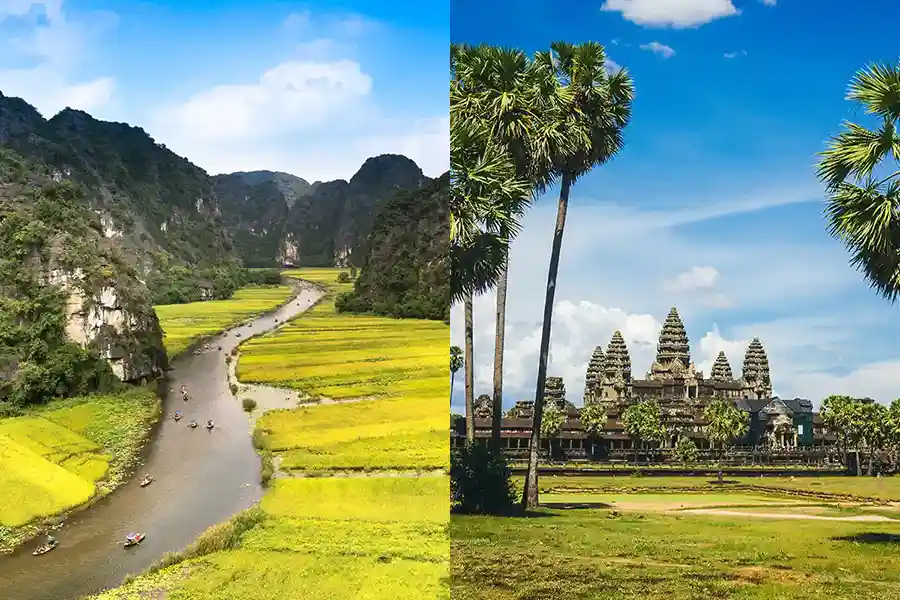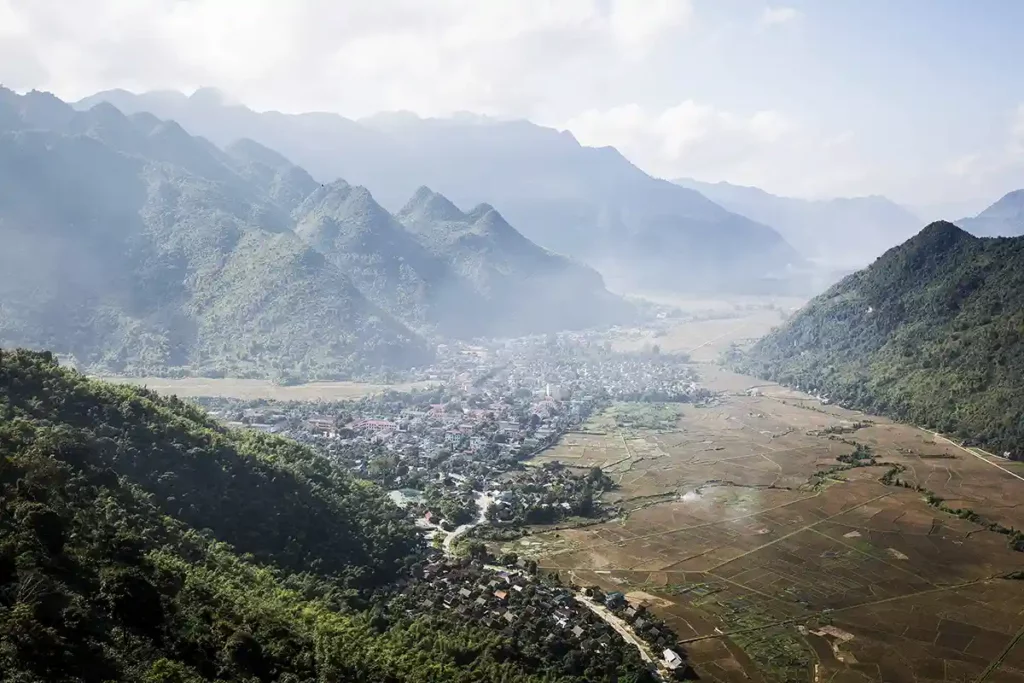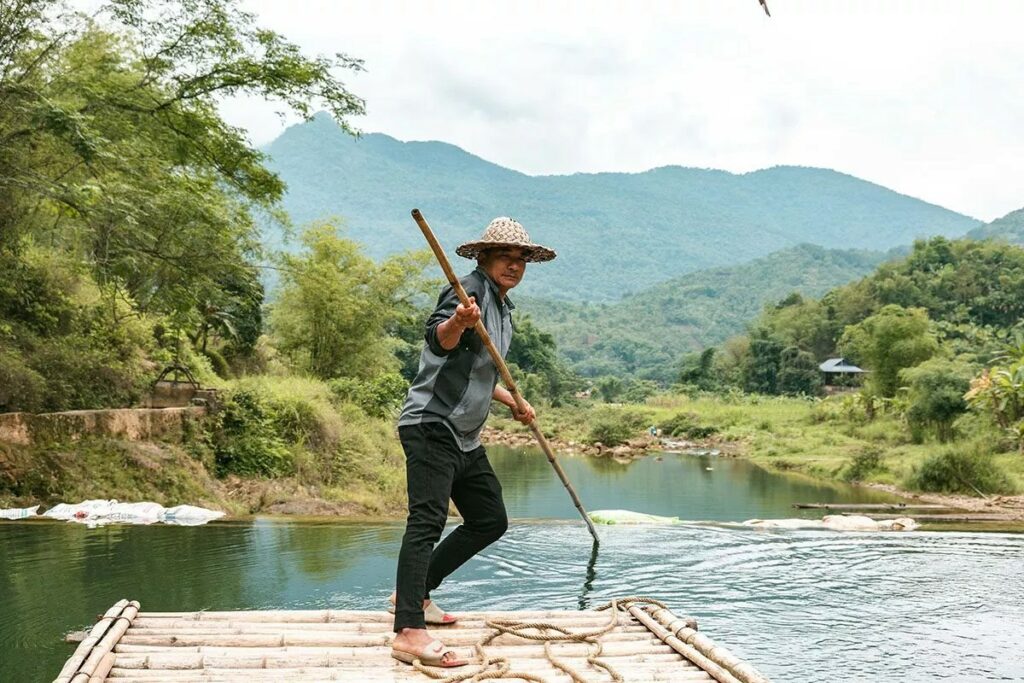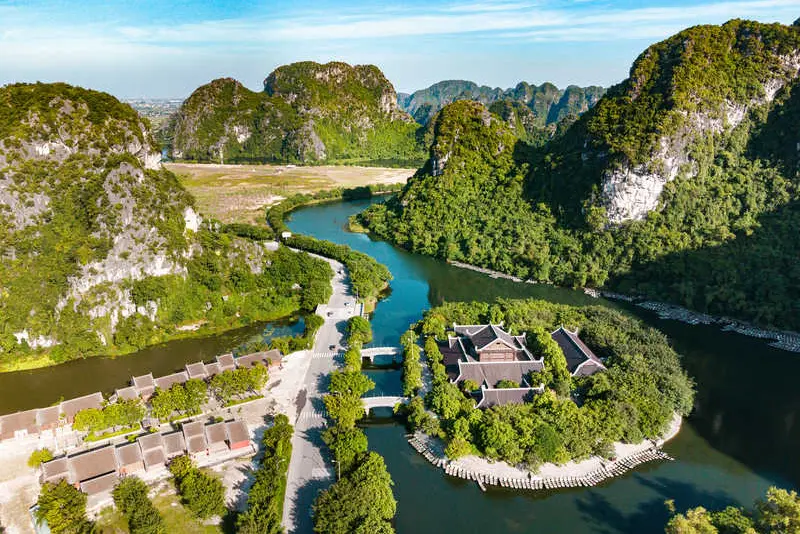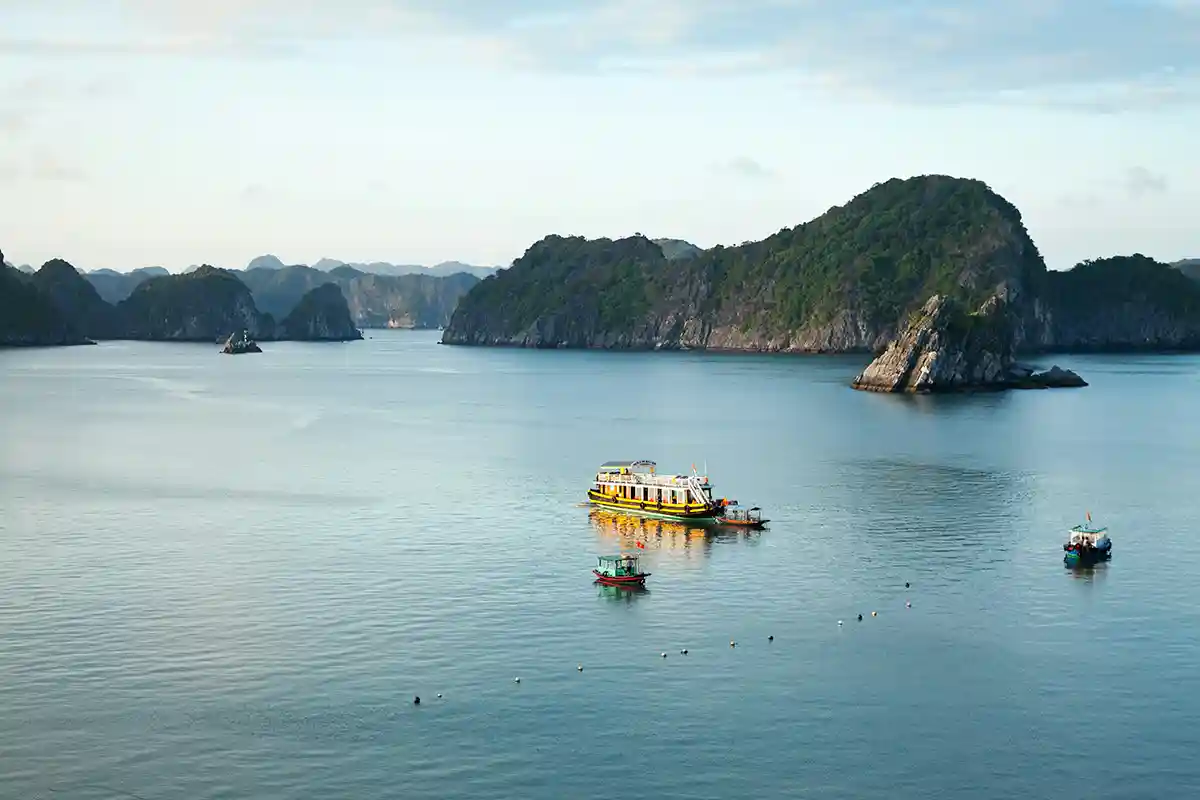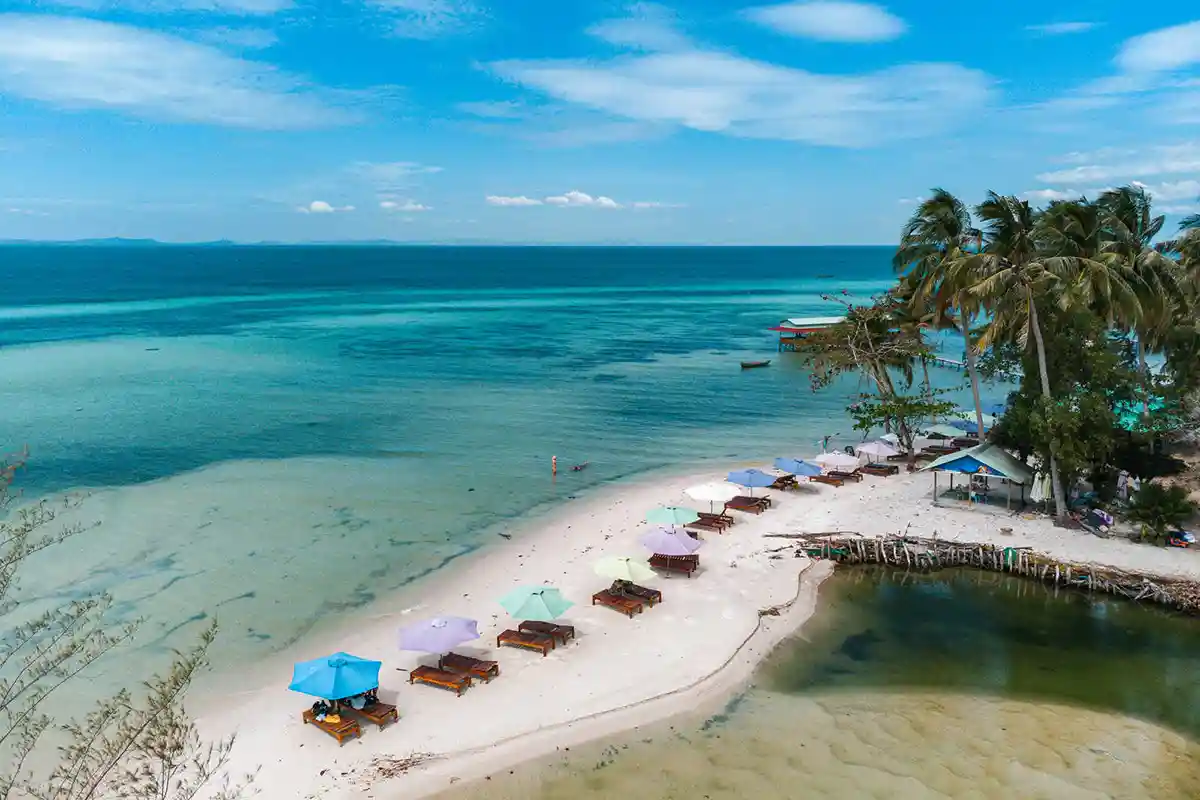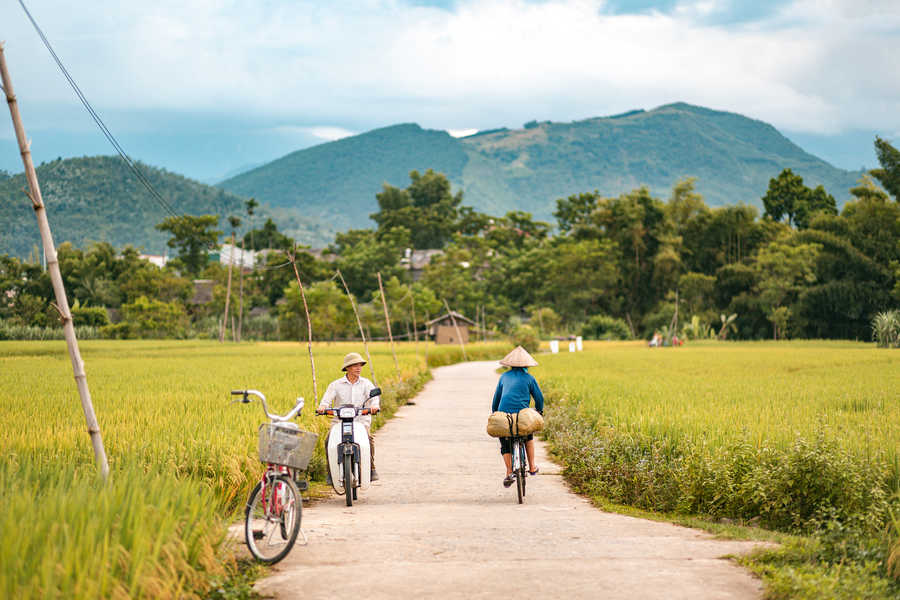Vietnam, a country with landscapes as varied as they are spectacular, is home to some of the most enchanting lakes in the world. These bodies of water, nestled between lush mountains or bordering ancient cities, offer a peaceful escape from the hustle and bustle of urban life. This article invites you to discover a selection of the most beautiful lakes in Vietnam, from the tranquil waters of Hoan Kiem Lake in the heart of Hanoi to the mysterious expanses of Ba Be in the mountainous north. Each lake tells a story, reflects a culture, and showcases biodiversity that deserves to be known and preserved. Embark on a visual and emotional journey through the aquatic wonders of Vietnam, where nature and legend blend harmoniously.
Most beautiful lakes in Northern Vietnam
Hoan Kiem lake (Hanoi)
Located in the heart of Hanoi, Hoan Kiem Lake, also known as the Lake of the Returned Sword, is an iconic symbol of the Vietnamese capital. This serene lake, surrounded by bustling streets and lush greenery, forms a peaceful oasis amidst the urban chaos.
The story of Hoan Kiem Lake is as rich as it is fascinating. According to legend, in the 15th century, Emperor Lê Lợi received a magical sword from a golden dragon living in the waters, which enabled him to drive out the Ming invaders from China. After successfully liberating Vietnam, a giant turtle appeared in the lake, taking the sword to return it to the divine beings, hence giving the lake its name. This legend is deeply embedded in Vietnamese culture and symbolizes the resilience and independence of the Vietnamese people.
Hoan Kiem Lake is a hub of cultural and social activity in Hanoi. Early in the morning, locals gather here to practice tai chi, walk, or jog, enjoying the cool and tranquil atmosphere. In the evening, the area around the lake comes alive with strollers and street vendors, creating a picturesque scene under the soft lights. On weekends, the streets surrounding the lake are pedestrian-only, allowing visitors to wander without worrying about traffic—a rare luxury in Hanoi!
In the center of the lake is Turtle Island, accessible via the Thê Húc Bridge, a charming bridge lacquered in bright red. On this island stands an elegant tower, Turtle Tower, which serves as a memorial to Vietnamese heroes. It is one of the most photographed landmarks by visitors.
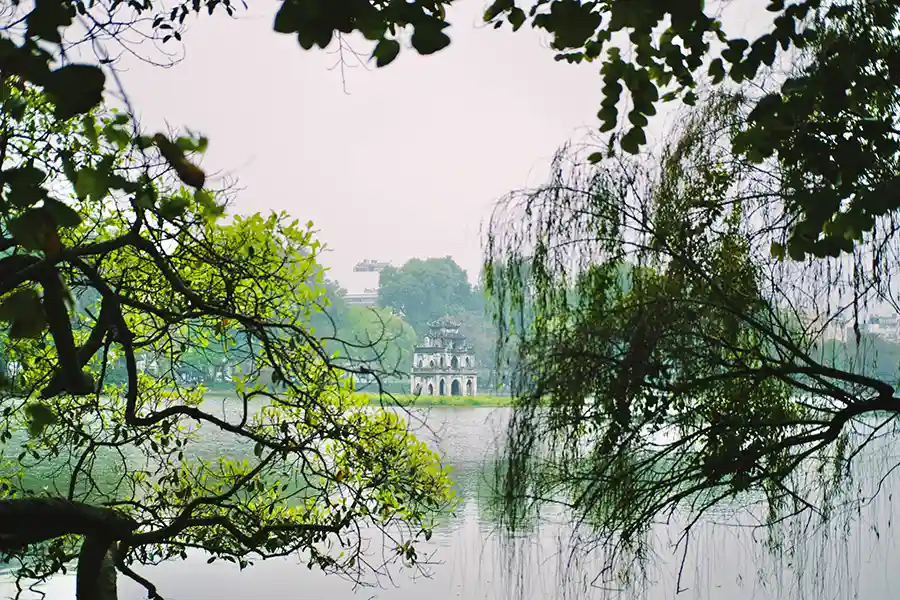
Hoan Kiem à Hanoi, Vietnam
West Lake (Hanoi)
West Lake, or Hồ Tây in Vietnamese, is the largest lake in Hanoi and one of the city’s most popular spots, both for locals and tourists. Located northwest of the city center, this vast natural body of water is surrounded by lush gardens, sophisticated villas, and serene temples, providing a picturesque escape from the urban hustle.
The origin of West Lake is shrouded in myths and legends, with tales dating back thousands of years. One of the most popular legends recounts that the lake was formed when the Dragon King, living underground, moved his body, creating valleys and mountains that were then flooded by celestial rains, giving birth to the lake. This story underscores the cultural and spiritual significance of the lake in the lives of Hanoi’s residents.
West Lake is a vibrant center for recreational and cultural activities. Visitors and locals alike engage in various activities such as kayaking, sailing, and even fishing. The shores of the lake are perfect for biking or walking, offering stunning views and a peaceful atmosphere. Around the lake, numerous cafes, restaurants, and clubs provide spots for relaxation and socialization, with breathtaking views of the water.
Among the historical and cultural sites around the lake, the most notable is perhaps Trấn Quốc Pagoda, the oldest Buddhist temple in Hanoi. Built in the sixth century, this temple is a spectacular example of Vietnamese Buddhist architecture and an important site for spiritual practice.
West Lake is not just a body of water; it is an integral part of Hanoi’s identity, reflecting the city’s history, culture, and natural beauty. Its presence continues to play a central role in the daily and spiritual lives of its inhabitants.
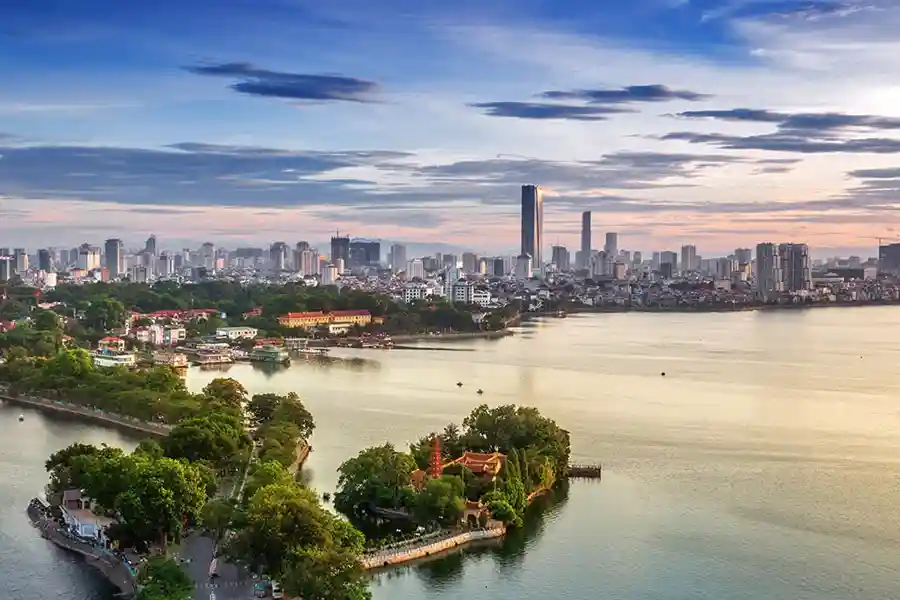
Sunset from West Lake, Hanoi
Hoa Binh lake (Hoa Binh province)
Hoa Binh Lake, located in the northern province of the same name, is a vast artificial body of water created by the construction of the Hoa Binh Dam on the Da River. Commissioned in the 1990s, this dam is not only a significant source of hydroelectric power for Vietnam but has also given rise to a lake that has become a major attraction for tourism and recreation.
Surrounded by mountains and lush forests, Hoa Binh Lake offers a spectacular site for nature lovers and those seeking tranquility. The region is home to several ethnic groups, including the Muong and Thai, who add cultural richness to the natural beauty of the landscape. Their traditions, unique architecture, and colorful markets provide an enriching cultural experience for visitors.
There are numerous activities around the lake. Tourists can explore the lake by boat, enjoy water sports like kayaking or fishing, or simply relax by the water. Hiking in the surrounding hills offers breathtaking views of the lake and valleys. Additionally, visitors can discover the small islands on the lake, each with its own character, often featuring small temples or traditional villages.
Near Hoa Binh Lake, you can explore Go Lao Waterfall, a stunning destination located in the Mai Chau area. This waterfall, formed by the confluence of the Thung Cang and Phieng Sa streams, presents an impressive natural setting with a 30-meter drop against a mountain. It is one of the most visited waterfalls in the region, partly due to its proximity to the tourist village of Lac and its easy accessibility, making it an excellent excursion to combine with a visit to Hoa Binh Lake and Thung Khe Pass.
On the southern side of the lake, you will find several accommodation options. For a unique experience, you can stay in a stilt house owned by ethnic minorities. These guesthouses are often simple and budget-friendly but offer a valuable insight into local culture. If you have a higher budget and seek more comfort, you can choose one of the resorts around the lake. The most renowned is the Mai Chau Hide Away Resort, which features an infinity pool with lake views, luxury bungalows, and offers activities such as kayaking and boat excursions.
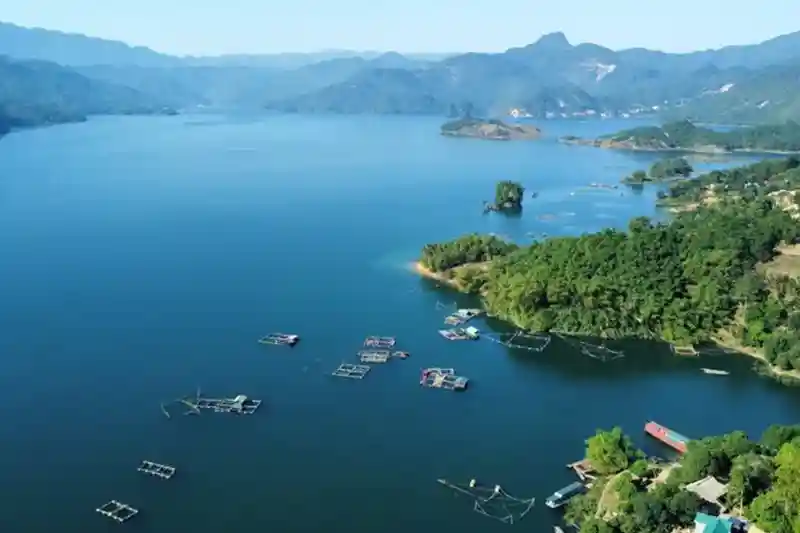
Hoa Binh lake, Vietnam
Thac Ba lake (Yen Bai province)
Thac Ba Lake is one of the largest artificial lakes in Vietnam, located in Yen Bai province in the north. Created in the 1960s following the construction of the Thac Ba Dam for hydroelectric power production, this lake spans over 23,400 hectares. It is surrounded by more than 1,300 islands and islets, each with lush vegetation and rich biodiversity, offering a stunning natural spectacle.
This region is significant not only for its contribution to Vietnam’s energy supply but also as a prime destination for ecotourism. Visitors can explore the lake by boat, a popular activity that allows them to discover the numerous islets and enjoy picturesque landscapes. These excursions often include visits to ethnic minority villages such as the Dao and Tay, who live around the lake. These communities provide insight into traditional lifestyles, often accompanied by demonstrations of folk dances and music.
Fishing is another popular activity at Thac Ba Lake, with the waters home to various fish species such as carp and perch. Nature enthusiasts can also enjoy hiking around the lake, offering opportunities to observe local flora and fauna, including rare bird species.
Beyond recreational activities, Thac Ba Lake holds spiritual significance for the locals. Several sacred sites, including temples and pagodas, are located on the islands and shores of the lake, making them pilgrimage destinations for Buddhist and Taoist devotees.
With its unique blend of natural beauty, ethnic culture, and spirituality, Thac Ba Lake is not just a hydroelectric marvel but also a crossroads of ecological and cultural harmony, attracting visitors seeking an authentically Vietnamese experience.
Around Thac Ba Lake, there are various accommodation options ranging from traditional homestays to more luxurious resorts, catering to different budgets and preferences:
- Traditional Homestays: Vu Linh Family Homestay and La Vie Vu Linh are popular choices that offer an immersive experience in local life. These homestays are located near the lake and provide cultural and recreational activities such as fishing, hiking, and swimming in the lake. La Vie Vu Linh is particularly known for its commitment to sustainable tourism and integrating local ethnic minorities into its activities.
- Luxury Options: For those seeking more comfort, Thác Bà Paradise Islands offers accommodations with river views and amenities such as a swimming pool and a bar. This establishment is noted for its tranquility and excellent service, making it an ideal option for those looking to relax in a more refined setting.
- Budget and Easy Access: Vu Linh Palm House Homestay offers a comfortable and affordable option with access to outdoor activities. Recently renovated, this homestay features an outdoor pool and a garden, providing a pleasant stay at a reasonable price.
Thac Ba Lake can also be combined with a visit to the most beautiful rice fields in Vietnam, located in Mu Cang Chai, Yen Bai province, about 200 kilometers away.
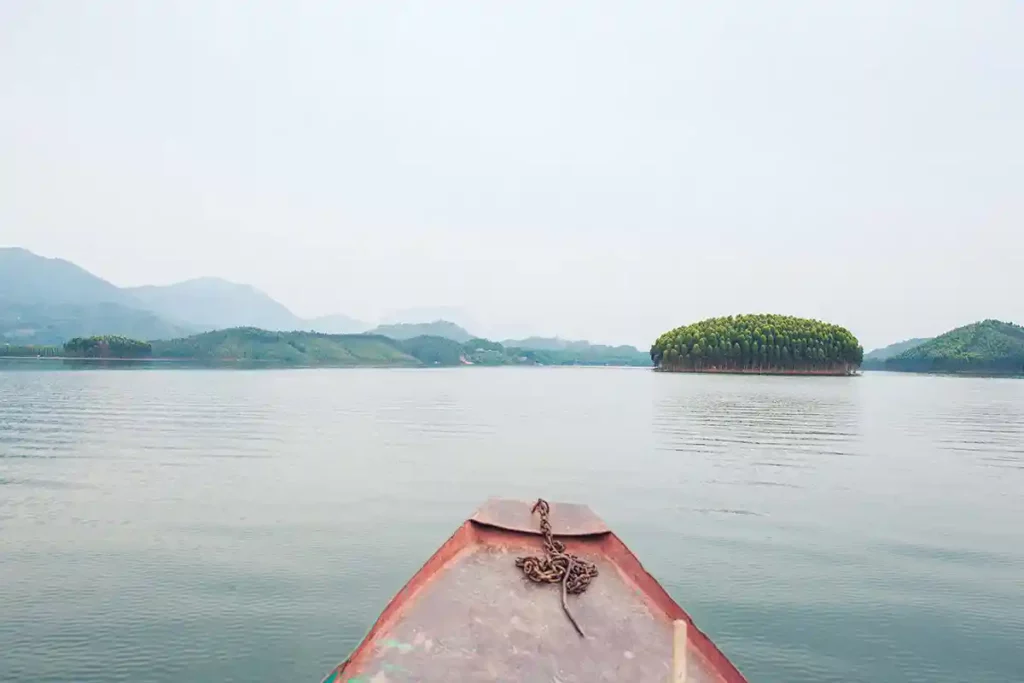
Thac Ba lake, Vietnam
Ba Be lake (Bac Kan province)
Ba Be Lake, located in the eponymous national park in Bac Kan province, northern Vietnam, is a natural treasure and the largest freshwater natural lake in the country. Formed around 200 million years ago in the limestone mountains, the lake is a geological marvel framed by ancient forests and towering karst cliffs.
Covering an area of over 650 hectares, Ba Be Lake is a vital part of the national park’s ecosystem, providing a habitat for a diverse range of animal and plant species. It is a prime spot for ecotourism, offering visitors the chance to explore the region’s rich biodiversity while enjoying the tranquil beauty of the landscape.
The lake is surrounded by three main lakes and over a hundred small ponds, fed by several sources that keep its waters fresh and clear year-round. Ba Be means “three seas,” a name given due to the three lakes that converge into one. Visitors can explore the lake by kayak or traditional boat, discover caves accessible only by water, and observe local wildlife, including rare birds and exotic butterflies.
The national park is also a cultural hub, home to several ethnic communities, primarily the Tay, who live in stilt houses around the lake. Visitors have the opportunity to stay in these traditional homes, taste local cuisine, and learn about the lifestyle of the indigenous communities.
Accommodation in the national park is currently limited, which some might say adds to its charm. Visitors can stay in homestays, such as the Ba Be Lake View Homestay, which offers stunning views of the lake and an immersive experience of local life.
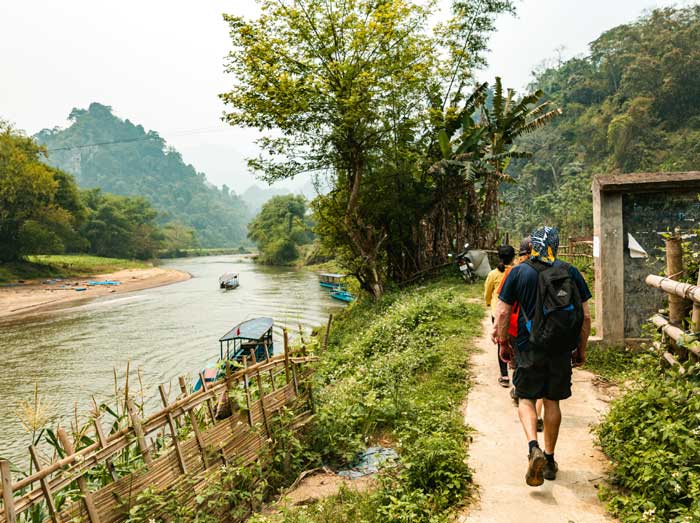
Trekking along Nang river, Ba Be national park, Vietnam
Na Hang lake (Tuyen Quang province)
Located between the districts of Na Hang and Lam Binh, 110 km from Tuyen Quang city, the provincial capital, Na Hang lies at the confluence of the Gam and Nang rivers and covers an area of 80 square kilometers.
Often compared to the famous Ha Long Bay, a UNESCO natural heritage site in the northern province of Quang Ninh, Na Hang has been dubbed the “Ha Long Bay amidst majestic mountains and forests.”
Visitors can begin their journey by renting a boat to explore the lake, visiting limestone mountains such as Pac Ta and the famous Coc Vai Pha rock. According to a traditional fairy tale, Coc Vai Pha rock is where the young giant Tai Ngao tied the reins of his buffalo.
A boat trip around Na Hang Lake typically lasts 4 to 5 hours, with stops at Pac Ta Temple, Phia Vai Cave, or Mo Waterfall. Adventurous visitors should also explore the Khuoi Nhi Waterfall.
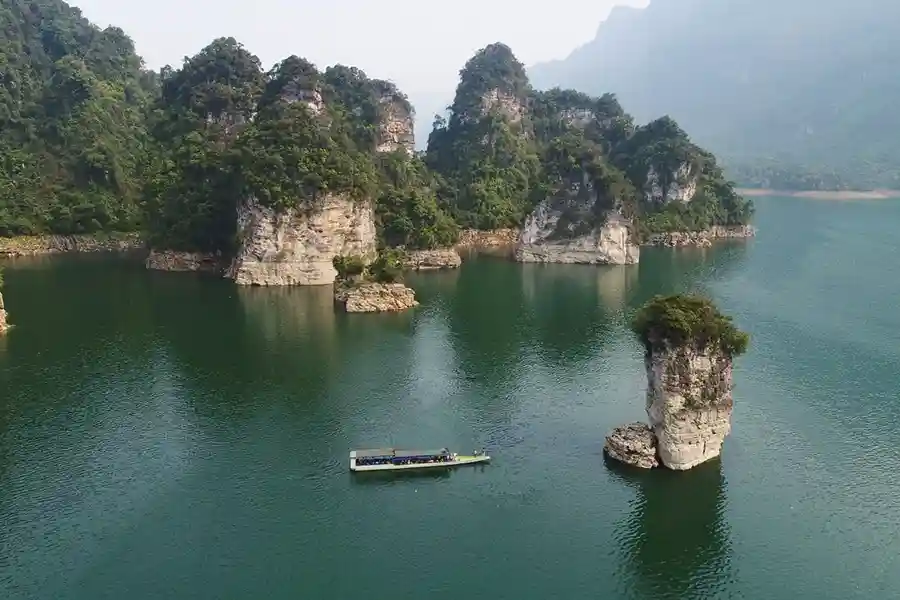
Na Hang lake, Vietnam
Thang Hen lake (Cao Bang province)
Thang Hen Lake, located in Cao Bang province, Vietnam, is a captivating eco-tourism destination. Nestled at over 1,000 meters above sea level, this lake is surrounded by lush mountains and is part of a cluster of 36 lakes in an impressive limestone mountain environment. The area is known for its tranquil beauty and emerald green waters, offering a spectacular setting and exceptional photography opportunities.
Thang Hen stands out for its unique honeybee tail shape when viewed from above and is particularly remarkable during the rainy season when it reaches its fullness, offering sublime landscapes and activities such as boating and bamboo rafting. During the dry season, a network of caves becomes accessible, adding an adventurous aspect to the visit.
The Eye Mountain, also known as “Núi Thủng Phja Piót,” is located near Thang Hen Lake in the same mountainous region of Cao Bang province. This area is less touristy and offers impressive natural landscapes, making it an excellent addition to a visit to Thang Hen Lake for those who enjoy exploring unique and tranquil places.
The region is also rich in local culture, with traditional villages nearby where visitors can experience the customs and cuisine of the local ethnic groups. Eco-tourism enthusiasts will find Thang Hen a perfect escape from the urban hustle and an opportunity to connect with Vietnam’s pristine nature.
To reach Thang Hen, visitors usually pass through Cao Bang and can consider a journey by motorbike or private transport through mountainous landscapes, making it an adventure in itself.
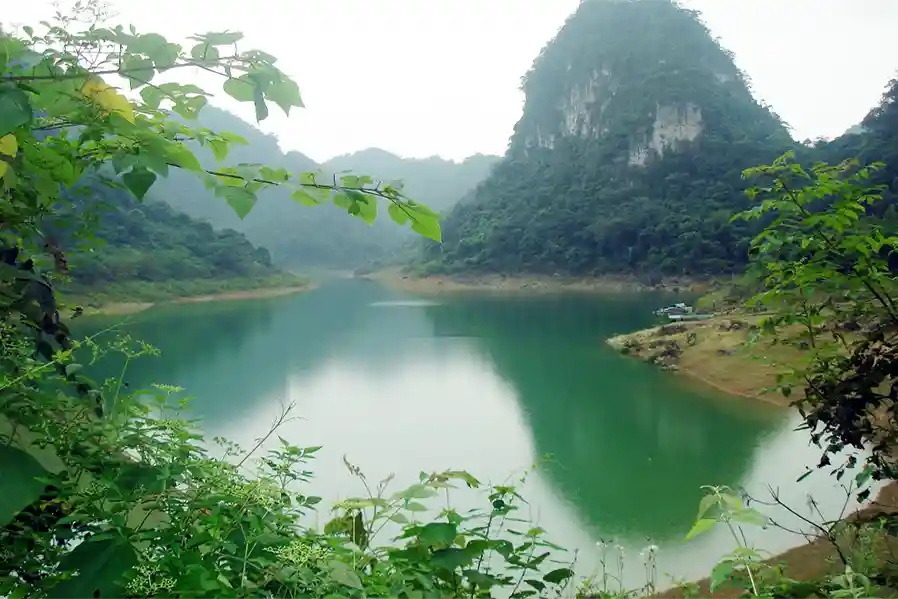
Thang Hen lake, Cao Bang province
The most beautiful lakes in Southern Vietnam
Tuyen Lam lake (Dalat, Lam Dong province)
Tuyen Lam Lake, also known as the “Paradise Lake,” is a natural treasure located about 6 km south of downtown Dalat in Lam Dong province, Vietnam. It is the largest artificial freshwater lake in the region, covering an area of 350 hectares. Created by the Tia stream, the lake is surrounded by lush pine forests and rolling hills, offering a peaceful atmosphere and breathtaking landscapes.
Recognized as a historical and cultural site in 1998 and designated as a national tourist destination in 2007, Tuyen Lam Lake is popular for various outdoor activities. Visitors can enjoy boat rides to explore the serene waters of the lake, participate in hikes around the area, or even camp by the lake for an immersive nature experience.
The lake is also close to the Truc Lam Zen Monastery, an important Buddhist center, accessible by cable car, offering stunning views of the lake and its surroundings. This proximity adds a spiritual dimension to the visit to Tuyen Lam Lake, making the experience both relaxing and enriching.
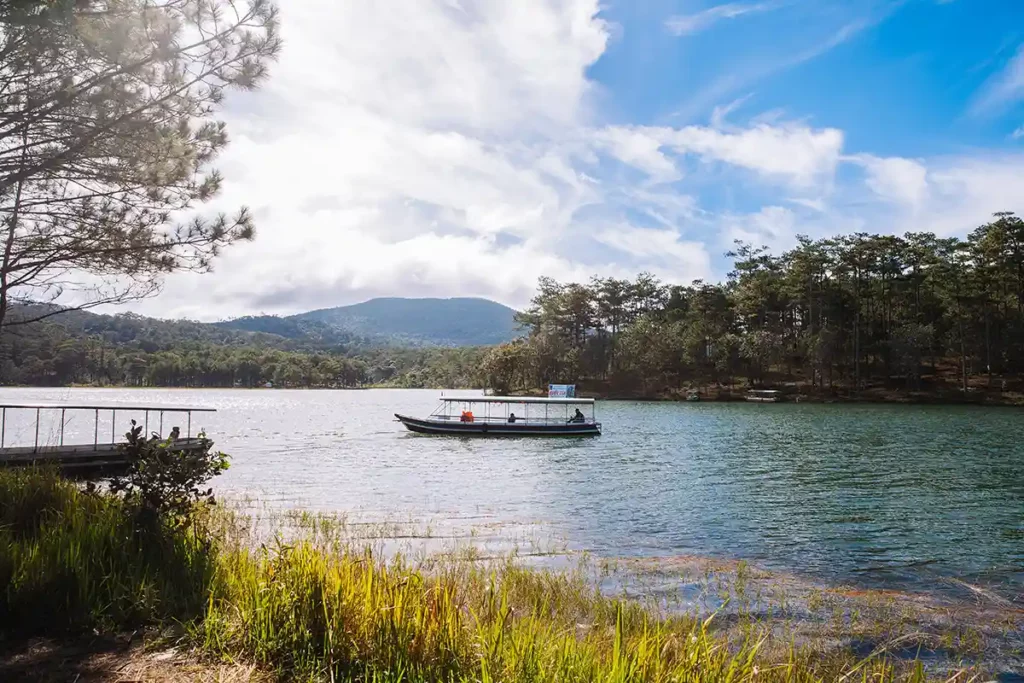
Tuyen Lam lake, Dalat. Photo : Mathieu Arnaudet
Lac Lak (province de Dak Lak, Hauts Plateaux)
Lak Lake, located in Dak Lak province in the heart of Vietnam’s Central Highlands, is the largest natural freshwater lake in the region and the second largest in Vietnam after Ba Be Lake. Surrounded by majestic mountains and pristine forests, Lak Lake is a true oasis of tranquility and offers a spectacular landscape, especially admired at sunset.
This lake is renowned not only for its natural beauty but also for its rich ethnic culture. It is primarily inhabited by the M’nong community, who have preserved a traditional lifestyle centered around the lake. Visitors can explore this unique culture by visiting the surrounding villages, attending gong performances, and discovering traditional longhouses.
Popular activities around the lake include canoe rides, an ideal way to experience the lake’s natural beauty. These traditional canoes, mainly used for fishing, allow for a peaceful and immersive exploration of the lake. In addition to boat rides, the lake is perfect for hiking and exploring the surrounding landscapes, rich in wildlife and flora.
Several attractions around Lak Lake are worth visiting to enrich your experience in Vietnam’s Central Highlands:
- M’nong Villages: Explore traditional villages such as Jun and M’Lieng. These villages offer a unique insight into M’nong culture with their longhouses and community activities. It’s an opportunity to discover traditional lifestyles and interact with locals.
- Former King Bao Dai’s Palace: Visit this historical site where the last emperor of Vietnam had a hunting lodge. This place is rich in history and offers beautiful views of the lake’s surroundings.
- Water Activities: Take a traditional canoe ride on the lake to enjoy the calm and beauty of the landscape. Canoe rides allow for an immersive experience in the lake’s tranquility and the surrounding nature.
- Hiking and Trekking: The hills and forests around Lak Lake are perfect for hiking, offering spectacular views of the lake and the surrounding mountains. It’s an excellent way to explore the region’s biodiversity.
- Waterfalls: Nearby, the Dray Sap and Dray Nur waterfalls offer magnificent landscapes where water flows through rocks and dense tropical forest. These falls are among the most impressive in the region and are worth a visit.
- Yok Don National Park: Close by, this national park is famous for its elephant conservation efforts and offers the opportunity to see these magnificent creatures in a more ethical and natural setting. It’s also a great place to observe other wildlife species and enjoy pristine nature.
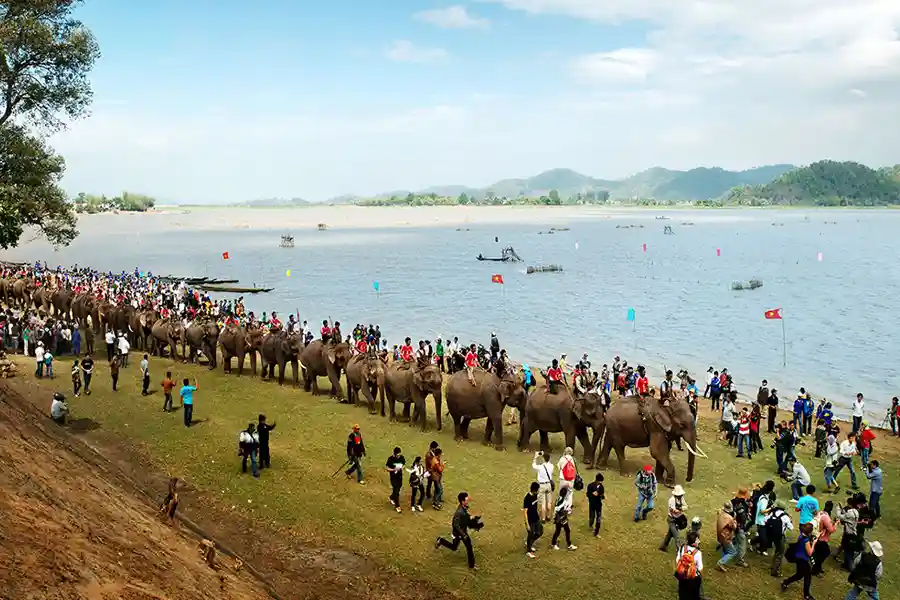
Lak lake, near Dak Lak, Highlands, Vietnam
Lakes in Mekong delta ?
In the Mekong Delta, southern Vietnam, the water bodies are primarily rivers and canals rather than traditional lakes. The region is traversed by the Mekong River and its numerous tributaries, creating a dense network of waterways. However, there are some water bodies referred to as “biển Hồ” in Vietnamese, which can be translated as “marine lakes,” though these are often widened areas within rivers or flood zones used for fishing and aquaculture. Visiting these areas offers a unique experience of river life and traditional activities in the Mekong Delta.
Here are a few examples:
- Biển Hồ Tràm: Located near Vung Tau, this is not a lake but rather a lagoon or estuary near the sea. The area is popular for its beaches and resorts, offering a combination of seaside relaxation and water activities.
- Biển Hồ Cần Giờ: This is a marshy area at the mouth of the Saigon River, known for its dense mangrove forests. Recognized as a UNESCO biosphere reserve, it is ideal for ecotourism and observing unique biodiversity.
These areas play a crucial role in the Mekong Delta ecosystem by helping to control floods, providing habitats for wildlife, and supporting local communities through fishing and tourism.
You now know the main lakes of Vietnam!
Our agency is here to organize a private tour combining culture and nature.

